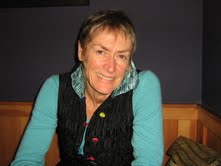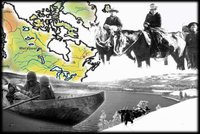
Leonie Sandercock, who commutes between Orcas Island and Vancouver, B.C. , is co-producer of "Finding Our Way" which will be viewed Saturday, Feb. 26, at Odd Fellows Hall.
Planners Consider Role Change as Negotiators, not Regulators
Next Saturday, Feb. 26 at 3 p.m., several Orcas faith and fellowship organizations invite the public to a viewing of the documentary, “Finding Our Way,” and then to a gathering to consider the movie’s application to our lives.
The event is sponsored by OPAL Community Land Trust, Orcas Council of Churches, and the Odd Fellows.
Leonie Sandercock, who with Giovanni Attili made “Finding Our Way,” recently explored the topics of growth and planning, as reflected in her body of work as an architect, anthropologist and an urban planner, including their treatment in the movie.
Although the movie is an indictment of the British Columbian and Canadian governments’ treatment of Native Americans, it is forward-looking as it considers ways to remedy the past and to honor the values of the people in the community whose land is being planned or developed. It emphasizes the importance of acknowledgment and apology, and of honoring the shared – and differing – values of any community.
Sandercock advances the idea that planners have for too long been in a regulatory role, and better serve all interests by acting as negotiators.
Sandercock was brought up and educated in Australia. She came to the U.S. to teach at UCLA in 1986, where she encountered “very challenging students,” in architecture and urban planning. “They represented the diversity of the city and said they didn’t see themselves in the studies,” Sandercock says. “They asked, ‘How can we be planners if it’s not understood that different groups are marginalized by the kinds of cities we live in’?”
Sandercock’s first book in the U.S. Making the Invisible Visible, was a multi-cultural history of planning, edited to include stories from different communities “telling their own story about the challenges they encounter.”
That book was a turning point for Sandercock in that the chapter about Native Americans, “blew me away: that chapter opened my mind. “The narrative brought out that before European settlers, the natives had planning traditions; ways of organizing themselves; regional planning to access resources at a regional level to work out collaboration and managing; those [habits] that we call community planning.
“Planners are accustomed to seeing themselves ‘heroically.’ I try to look at the ‘dark side’ and how culturally specific that perception is.
“The [planning] process should entertain the questions: what is a good city? What is a just city? I’ve always been interested in consideration of who’s winning, who’s losing from public policy; who’s been marginalized?
“In a caring society, no person is left behind. Some societies make that a priority. Americans struggle with it, with some exceptions, such as the War on Poverty, started during President Lyndon Johnson’s presidency, or the Welfare to Workfare policies of the 1990s.
“Our society is divided on what people think is just and fair and good.”
She looks at the way Vancouver B.C. has dealt with questions of development, saying, “People rather than profits formed neighborhoods, making them more livable.”
This viewpoint has been advanced in the last 30 years, Sandercock maintains, by a commitment to negotiation with developers (who are often “much maligned by idealistic planners,” she says.)
And so she has come to advocate the planner’s role as negotiator, rather than regulator.
“Sometimes the regulations are the problem, and the emphasis has been way too much on a regulatory approach; the planner becomes the compliance officer with rules. Then investors get frustrated and angry. The whole regulatory, rule-based approach is so unsatisfactory and frustrating; it’s always adversarial.
“What works is a negotiated approach, a collaborative approach, where you sit down as a society and agree on the values about the kind of community you want. Then [a community] handles the process and develops growth on an ongoing basis, realizing everyone has a voice,” says Sandercock. She adds, “The ‘relevant stakeholder’ was narrowly defined at first; now it’s recognized to be a broader group.
“Progressive planning requires more people skills to facilitate meeting, to bring out listening and empathy, creating shared values around place and community.
“The challenge as a planner is to design a negotiation process through dialogue that refers back to the agreement of values… How to live together, to coexist in shared spaces of our neighborhoods and cities — not to mention our planet!”

Maps and moving waters accompany songs, photos and interviews to tell the story of "Finding Our Way" next Saturday at 3 p.m. at Odd Fellows Hall
The documentary “Finding Our Way” tells three chapters of the “planning” experience and way forward of three bands of the British Columbian Carrier Tribe, so called because of its custom of a widow carrying her husband’s ashes for three years.
In “The Contagion of Colonization,” the film documents the Canadian national policy towards First Nation, or Native American peoples, as set forth in the Indian Act of 1876. (This law was specifically studied by legislators in the South African government when codifying their laws of apartheid.)
The Indian Act provided for three instruments of the destruction of native culture: the reservation system of Indian lands, Indian Agents that rendered natives dependent upon the Canadian government and Reservation Schools. With the Canadian government’s and European settlers’ “assumption of cultural superiority,” the goal of assimilation effectively destroyed Indian families and culture.
A haunting song composed for the film, ”Where Did you Go When They Took You Away?” plays throughout the movie. The song brings out the tragedy of preventing Indian children from living with their own parents, speaking their own language or practicing their own culture
The fallout has been tragic, Sandercock says. “Children who never learned what loving attachment means, don’t understand what human bonds are. The desired effect — written in government documents — is to completely destroy a culture, in a couple of generations.”
The film then explores specific cases of what Sandercock calls “stories of extraordinary injustice” that arose, in one case, over taxation stemming from an 80-year history of conflict between the municipality of Burns Lake Village and the Burns Lake Band of the Carrier Nation.
The third chapter of “Finding Our Way,” tells the story of the Cheslatta Band, who had been forced from into a reservation in the 1910s and lived in self-sufficiency — gardening, fishing and trapping — until 1952, when they were forced to leave their native homes.
This chapter, titled “Keeping Our Heads Above Water,” describes how the Indian agent told the community of 307 people that they had 10 days to leave before their land would be flooded, in order to build a hydroelectric dam for an aluminum company’s smelter. The Native Americans would be given “tiny” compensation.
The logic of the old Indian Act was maintained in this policy, for white settlers who were similarly “evicted” were given a two-year time frame and assigned lawyers to work out financial compensation.
Sandercock says the Natives were “most worried about their ancestral gravesites and the spirit houses where they worshipped. They were promised that the spirit houses would be relocated, “but instead the spirit houses, homes and churches were burned by the Indian agent.”
Faced for the first time in their life with racism, the band’s existence “becomes a story of descent into societal chaos, with a huge percentage of alcoholic deaths and suicide.”
Sandercock asks rhetorically, “Given the toxic history, is there a way forward?”
A community organizer invited Sandercock, who had produced a film about immigrants in Vancouver building a harmonious community, to “explore” the Cheslatta people. She spent a year being introduced to band chiefs, asking questions, listening and wondering, ‘What’s behind the story?’
The community was particularly welcoming, she says, and “was looking for someone to tell their story.”
In addition to laying bare the history of racism and governmental injustice, the film provides answer in stories of hope, forgiveness and redemption and efforts in place to work together
In the last 20 years both the Burns Lake Band and the Cheslatta Band have undergone revitalization through the leadership and wisdom of the chief in reconnecting with their identity, Sandercock says. They have returned to the land, and revived traditional practices, recovering their cultural identity.
High school kids wrote an anti-racist song, “Leave it Behind,” which fused rock music and drumming, and challenged the way the community was being run.
The Burns Lake Band took their taxation case to the Supreme Court, who ruled in favor of the band.
The Burns Lake Reservation and the Burns Lake Village were brought together to hear the messages of injustice and ways to make changes.
A high school has been transformed into a community center (rather than a bingo parlor, one alternative proposed), complete with the presence of the Royal Canadian Mounted Police.
Resolution is an ongoing matter, the documentary brings out; planning means continued dialog and definition. “This partnership is shared opportunities, shared control and shared resources; it’s not about tokenism or logos,” says one Burns Lake resident.
For the last nine months Sandercock has presented “Finding Our Way” to communities in conflict, inviting them to reflect on “what seems to relate within their own community,” she says. She is hoping to bring Jerry Oleman, head of the Aboriginal Healing Foundation, a natural leader and former chief of the Carrier Nation, to the Orcas showing.
Sandercock says, “The healing work in this film is to look at the past with fresh eyes.”
Leonie Sandercock is married to John Friedmann and they maintain a home on Orcas Island. She joined the School of Community & Regional Planning at University of British Columbia in July 2001 and became Director of the School in July 2006.
She was Professor and Head of Graduate Urban Studies at Macquarie University in Sydney from 1981-1986, before moving to Los Angeles where she had two careers, one in screenwriting, the other teaching in the Graduate School of Architecture and Urban Planning at UCLA.
She has also written books about sport (Australian football) and about the Australian labor movement.
Her best known urban writings are Cities for Sale (1975); Public Participation in Planning (1975); The Land Racket (1979); Urban Political Economy: the Australian Case (1983), with Mike Berry; Making the Invisible Visible: A Multicultural History of Planning (1998); and Towards Cosmopolis: Planning for Multicultural Cities (1998).
She published her tenth book, Cosmopolis 2: Mongrel Cities of the 21st Century in 2003.
**If you are reading theOrcasonian for free, thank your fellow islanders. If you would like to support theOrcasonian CLICK HERE to set your modestly-priced, voluntary subscription. Otherwise, no worries; we’re happy to share with you.**





